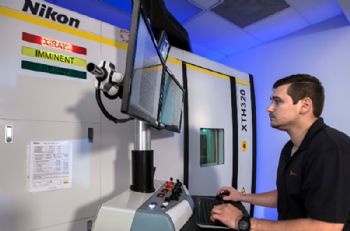
Metal additive-manufacturing (AM) company Sintavia (
www.sintavia.com) has installed a computed tomography (CT) system at its facility in Florida (USA) to help ‘control’ the AM process.
The company is a global leader in the application of AM technology, providing a high-end design-to-production sub-contract service to customers in a variety of sectors, including aerospace and automotive, as well as and oil and gas.
It has eight high-speed additive-manufacturing machines, along with post-processing equipment, metrology and mechanical testing laboratories, as well as various quality assurance tools.
Using the powder-bed process with electron and laser beam melting, Sintavia currently makes components from Inconel 718 and 625, aluminium, titanium, cobalt-chrome and stainless steel — plus other proprietary powders.
AM allows special internal designs to be produced, such as conformal cooling channels, lattice networks, hollow members and other complex geometries.
However, both additive and traditional manufacturing can leave microscopic voids and gaps within structures, potentially causing stress fractures and reducing the operating life of a component. These internal features can only be inspected non-destructively with CT scanning.
Brian Neff, Sintavia’s CEO, said: “There are thousands of metal AM machines in place globally, with just as many people — if not more — still figuring the process out.
“We’re working with our customers to develop optimal parameters for their builds. This demands nothing less than total process knowledge and understanding. We can optimise parameters, manufacture and audit quality much faster than any of our competitors.”
To assist in enhancing this capability and achieving the required level of quality control, the company decided to invest in the latest CT scanning technology.
Other AM companies often out-source this aspect of inspection, but Sintavia wanted the equipment in-house to ensure rapid inspection and achieve full control over the quality of products.
Mr Neff says the fact that manufacturing standards are highest in aviation drives the need for processes that are robust and repeatable, adding that “it is essential to know whether voids or inclusions are present, how large they are — both individually and in total volume — and where they occur.
"It is also necessary to know whether the dimensions of the part conform to those of the design. X-ray computed tomography is the tool Sintavia uses for assessing the quality of our AM parts.”
The company has installed a 450kVA micro-focus computed tomography (micro-CT) system from Nikon Metrology (
www.nikonmetrology.com).
By converting 2-D pixels to 3-D voxels (a voxel is a value on a regular grid in three-dimensional space) and supplying a full 3-D map of the samples, all the necessary information is presented in a ‘visual easy-to-interpret’ format and shows any departure from the CAD model.
Mr Neff said: “It is straightforward to detect and measure powder residues blocking channels, porosity,contamination, cracking, warping and dimensions such as wall thickness to an accuracy within tens of microns.
Given a 100mm sample and a detector 2,000 pixels across, the limiting resolution would be 50µm, for example.
“Micro CT is now much faster and more suitable for production-line use, and CT scanning of similar parts can be automated, by using loading and unloading equipment.
“Scan times down to just a few tens of seconds per part are possible.”